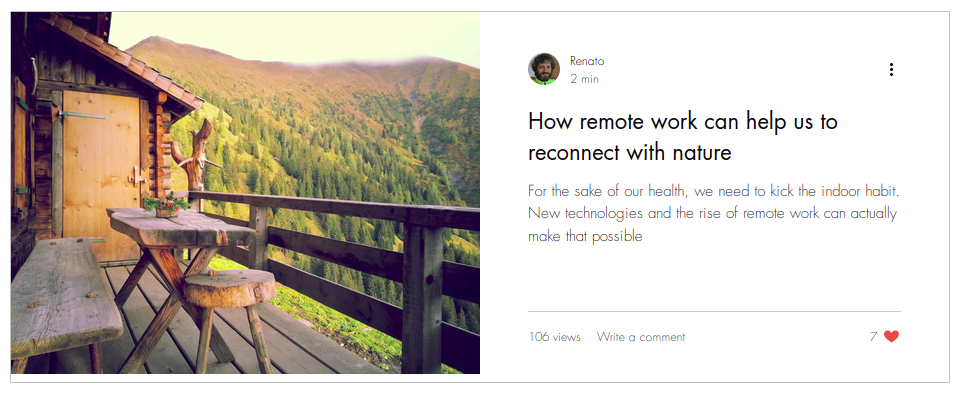We need to kick the indoor habit and new technologies and the rise of remote work can actually make that possible. My thoughts on how remote work can help us reconnect with nature as originally posted on Caryzma.

Just a couple of generations ago, most jobs had a significant outdoor component. Today, instead, most jobs are performed in an environment with air conditioning and artificial lights, working indoors every day.
But as Vybarr Cregan-Reid wrote in the Guardian, we are only beginning to understand the health risks associated with living and working indoors. And “for the sake of our health, we need to kick the indoor habit“. New technologies and the rise of remote work can actually make this possible.
Too many people associate the dream of working remotely, almost entirely in the tech sector, with working from the beach in Bali. A grand vision, a dream for many, but hardly a practical or sustainable approach for most.
On the flipside, others see location independence just as a way to avoid the commute and stay away from the office, to work alone in the bedroom, or share a desk in a co-working space.
If spending too much time at home or in the office confuses our bodies, how can we work remotely without being simply addicted to the WeWork of this world? Is “free coffee” a good reason to spend the whole day indoors? How could we swap an ergonomic chair in the office for a wooden bench near the lake? Can we really work outdoors?
If working in the woods every day is not feasible, there are different options that can add some outdoor time for most office and tech jobs. Here are a few suggestions:
1) When you’ve got a one-on-one meeting, go for a walk and have a walking meeting. This TED talk by Nilofer Merchant tells you why and how.
2) Not every conference call requires visual interaction. No matter what platform you use (Skype, WebEx, Google Hangouts Meet, etc.), there is a mobile client. Ride your bike or relax in the park while listening to your company’s weekly meeting.
3) Most cities have large parks, a good 4 G coverage and natural areas just a few metro stops away. Try to spend half a (work) day in a forest carrying your laptop or taking a few papers. An old tree stump in the forest could be a temporary stand-up desk. You’d be surprised how much your time management is going to improve.
4) We all need more training: want to see some of the presentations of a cool conference? Catch up on a few new Coursera courses? Bring the tablet to the local park or woodland. You’re going to focus better and get some fresh air, too.
As Vybarr Cregan-Reid concluded, “If urban planning for the future is to succeed, it must take into account all human needs: not just food, water and shelter, but sunshine as well.” So forget about the air conditioning, the artificial lights and the noisy cafes, take the challenge to work anywhere and make it more sustainable as well.